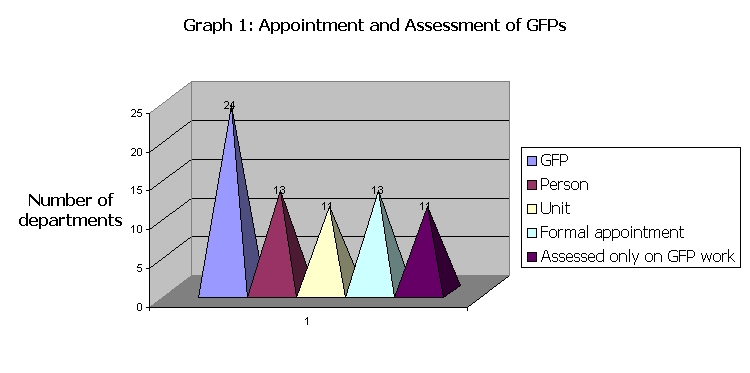
The Status of Gender Focal Points in National Departments
Audit April 2002
1.0. Introduction
South Africa is signatory to the Beijing Platform for Action (BPFA). Strategic Objective H of the BPFA recognises the obligation of state parties to create or strengthen, as appropriate, national machineries for the advancement of women. The BPFA recognises the role of gender machineries as that of supporting government wide mainstreaming of a gender equality perspective in all policies and programmes.
The Platform for Action identifies the necessary conditions for effective functioning of national machineries as follows:
The Cabinet Memorandum of 1996 (number 3 of 1996, dated 27 June 1996, file number 13/1/1/1) provided for the establishment of the Office on the Status of Women (OSW) in The Presidency. Additionally, it provided for the establishment of Gender Focal Points (GFPs)in national departments
In 1998 the OSW completed an audit of systems in place in national departments to facilitate effective gender mainstreaming. Based on the findings of the Audit, the National Gender Policy Framework on Gender Equality and Womens Empowerment made specific recommendations on the requisite status and location of Gender Focal Points in national departments.
Based on the recommendations of the Gender Policy Framework the National OSW of women conducted a survey on the status of GFPs in National Departments. In each department the questionnaire was sent to the office of the Director General.
The questionnaire was sent to thirty six (36) departments. (Attachment two: List of departments that were sent questionnaire). Twenty five (25) departments responded to the questionnaire. (Attachment three: List of departments that completed the questionnaire).
The National Gender Policy Framework on Gender Equality and Womens Empowerment and Gender Equality and the Institutional Mechanisms for Gender Equality
Paragraph 4.4.2.4.2 of the National Policy states that the responsibility for gender in national departments rests with the Directors General of the department.
Paragraph 4.4. 2.4.2 further makes provision for the placement of the GFP in the office of the director general to enable effective gender mainstreaming of the departments programmes
Paragraph 4.4.2.4.3 asserts that the GFP should be appointed at director level, and draws attention to chapter five, table five which identifies the skills requirements consumerate with the recommended level for the post of the GFP in national departments
The purpose of the survey was to access the extent to which government departments are complying with the provisions of the National Policy Framework and thereby Strategic Objective H of the BPFA
The survey did not assess the skills levels of GFPs since the focus at this stage is on the systems in place and the premise is that the National GFP is very clear about the requisite skills and expected outputs. (Attachment one: Questionnaire on the status of GFPs in national departments.)
1.1 Summary of the Findings
2.0 Findings of the Survey
2.1 Appointment and Assessment of GFPs
Twenty five (25) out of thirty six (36) departments responded to the questionnaire. Twenty four (24) of the responding departments reported having a gender focal point. (Attachment four: Appointment and assessment of GFPs.)
Eleven (11) of these reported that their GFPs were units whilst thirteen (13) reported that an individual constituted their gender focal point.
Thirteen (13) departments reported that the gender focal points were formally appointed in the position of GFP. Therefore the GFP position in (11) responding departments was informal or adhoc.
Eleven (11) reported that GFPs are assessed only on GFP work, however, only three (3) departments reported that their GFP performs only gender work (Graph 5).
That is, of the twenty five (25) departments who responded, 44% were assessed on work outside the functions identified in the Policy Framework as the functions of GFPs. Thus there was no compulsion or incentive for the GFPs in 44% of the responding departments to perform GFP functions.
Based on the above, less than fifty percent of the responding departments could claim to have formally appointed GFPs.

2.2 Human Resources Capacity of GFPs
In most departments the term gender focal point refers to an individual (13 departments), six (6) departments have three people or less in the unit. Two (2) departments reported having more than five people in their gender unit.
Most units are headed by a Deputy Directors (eleven departments). One department is headed by a Chief Director and six (6) departments are headed by Assistant Directors.
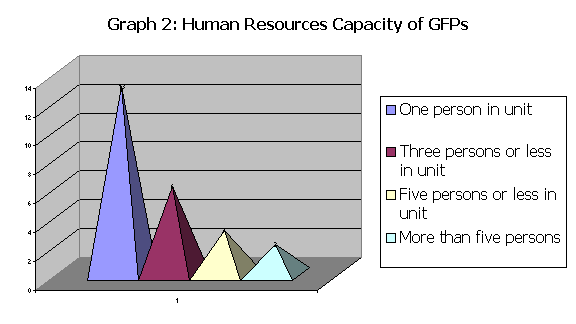
Graph 2 illustrates that of the eleven (11) departments which reported to have units dedicated to gender work:
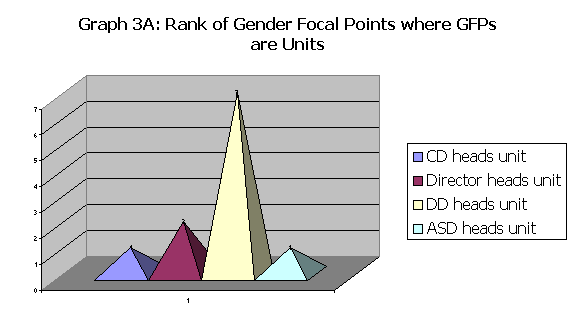
Graph 3A illustrates that:
Of the thirteen (13) departments that reported that their GFP was an individual, four (4) of these GFPs were Deputy Directors and two (2) were Directors. The rest were Special Programme Officers whose ranks were Assistant Director or lower.
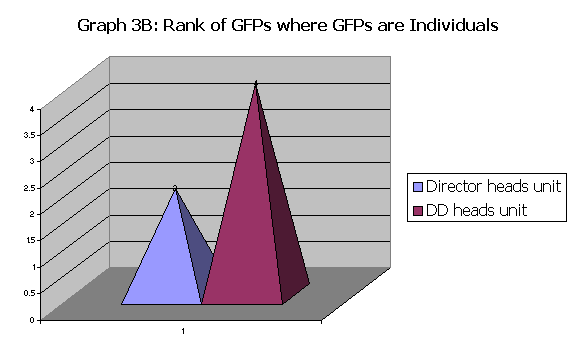
Graph 3B illustrates that of the departments which have an individual as the GFP:
For eleven (11) out of twenty five (25) departments, their gender focal points were below the Director level, and indeed nine (9) GFPs were supervised (or reported to) a person at director level.
That is, they reported to a person at entry point managerial level who in turn had other responsibilities beyond the supervision of the person allocated gender work. Only in three (3) departments (12%) did the GFP occupy the level proposed in the Policy Framework. Only in three (3) departments did the GFP report directly to the accounting officer. Only sixteen (16) departments (64%) reported that the supervisor for the GFP had gender identified as one of their key performance areas
The reporting lines are unclear. The person that the gender focal points report to range from Assistant Director to Directors General. One department reported that the gender focal point does not generate reports at all.
The OSW received conflicting responses in this regard. Eleven (11) departments report that the GFP units are headed a Deputy Director (Graph 3A) and four (4) departments report that the GFPs (where these are not units) are Deputy Directors (Graph 3B). However, most departments (nine) reported that the GFP report to Deputy Directors, effectively saying that the GFPs report to themselves or to officials of the same rank.
In spite of this, eleven (16) departments reported that the people they report to have gender as a key performance area.
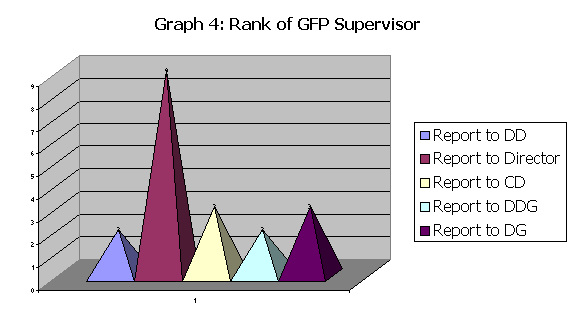
Graph 4 illustrates that:
When asked what functions were performed by the GFP only 3 (12%) departments responded that the functions performed by GFP functions were those identified in the National Gender Policy Framework. For twenty one (21) departments (84%) the classical fruit-basket of tasks prevailed.
Only three GFPs reported performing gender work exclusively. Yet thirteen (13) departments reported having formally employed gender focal points and eleven (11) departments reported that these gender focal points are assessed exclusively on their gender work.
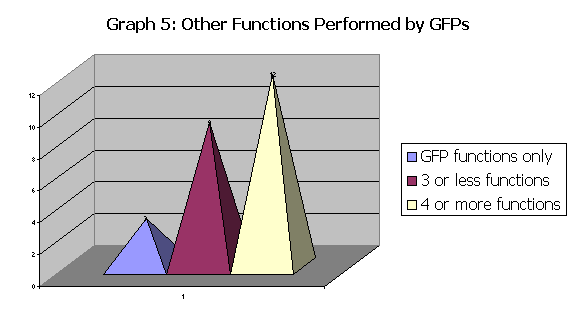
Graph 5 illustrates that:
Attachment One: Questionnaire on the Status of GFPs in National Departments
1. Is there a Gender Focal Point (GFP) in your Department?
2. Is the GFP a unit or is the Focal Point a person?
2.1 If it is a unit:
i. How many persons are in the unit?
ii. What are the ranks of the persons employed in the unit?
2.2 If it is a person:
i. What rank is the person?
3. Was the GFP formally appointed as a GFP, i.e. were they appointed to do the functions listed in Cabinet memo 3 of 1996?
4. Is the GFP in your department paid/or assessed for their GFP functions or are they employed for another role, e.g. Human Resource Officer, other than the Gender Programme as outlined in Cabinet memo of 1996?
5. What other functions are performed by your GFP? Please tick.
HIV/AIDS Programmes
Chilterns Rights .
Youth .
Disability .
Other ..
6. Who does the GFP reports go to? (What is their rank and designation).
7. Is the person whom the GFP reports to accountable for the GFP (i.e. is Gender a performance area they are required to be assessed on)?
8. Describe the reporting lines from GFP to the Director General/accounting officer in the Department.
Attachment Two: Recipients of OSW Questionnaire on the Status of National GFPs
Attachment Three: List of Departments that Responded to the Questionnaire
Attachment Four: Table 1 Appointment and Assessment of GFPs
|
Department |
GFP |
Person |
Unit |
Formal appointment |
Assessed only on GFP work |
|
Arts, Culture, Science and Technology |
X |
x |
|||
|
Defence |
X |
x |
X |
x |
|
|
Education |
X |
x |
X |
x |
|
|
Environmental Affairs |
X |
x |
x |
||
|
Government Communications and Information Systems |
X |
X |
X |
x |
|
|
Home Affairs |
X |
X |
|||
|
Independent Complaints Directorate |
X |
X |
|||
|
Labour |
X |
x |
|||
|
Land Affairs |
X |
x |
X |
x |
|
|
Minerals and Energy |
X |
X |
X |
x |
|
|
National Intelligence Agency |
X |
X |
X |
x |
|
|
Provincial and Local Government |
X |
X |
|||
|
Public Enterprise |
X |
x |
X |
x |
|
|
Public Service and Administration |
X |
x |
|||
|
Public Service Commission |
X |
X |
|||
|
Public Works |
X |
X |
X |
||
|
SA Police Service |
X |
X |
X |
||
|
SA Revenue Service |
|||||
|
SA Secret Service |
X |
x |
|||
|
SA Management Development Institute |
X |
x |
X |
||
|
Social Development |
X |
X |
X |
x |
|
|
Statistics SA |
X |
x |
X |
x |
|
|
Trade and Industry |
X |
X |
X |
x |
|
|
Treasury |
X |
X |
|||
|
Water Affairs |
X |
x |
|||
|
Total |
24 |
13 |
11 |
13 |
11 |
Attachment Five: Table Two Human Resource Capacity of GFPs
|
Department |
One person in unit |
Three persons or less in unit |
Five persons or less in unit |
More than five persons |
|
Arts, Culture, Science and Technology |
X |
|||
|
Defence |
X |
|||
|
Education |
X |
|||
|
Environmental Affairs |
x |
|||
|
Government Communications and Information Systems |
X |
|||
|
Home Affairs |
X |
|||
|
Independent Complaints Directorate |
X |
|||
|
Labour |
X |
|||
|
Land Affairs |
x |
|||
|
Minerals and Energy |
X |
|||
|
National Intelligence Agency |
X |
|||
|
Provincial and Local Government |
x |
|||
|
Public Enterprise |
x |
|||
|
Public Service and Administration |
x |
|||
|
Public Service Commission |
X |
|||
|
Public Works |
X |
|||
|
SA Police Service |
X |
|||
|
SA Revenue Service |
||||
|
SA Secret Service |
X |
|||
|
SA Management Development Institute |
X |
|||
|
Social Development |
X |
|||
|
Statistics SA |
x |
|||
|
Trade and Industry |
X |
|||
|
Treasury |
X |
|||
|
Water Affairs |
x |
|||
|
Total |
13 |
6 |
3 |
2 |
Attachment Six: Table 3 - Rank of Gender Focal Points; Departments which have Gender Units
|
Department |
CD heads unit |
Director heads unit |
DD heads unit |
ASD heads unit |
|
Arts, Culture, Science and Technology |
x |
X |
||
|
Defence |
x |
|||
|
Education |
x |
|||
|
Environmental Affairs |
X |
|||
|
Labour |
x |
|||
|
Land Affairs |
x |
|||
|
Public Enterprise |
x |
|||
|
Public Service and Administration |
x |
|||
|
SA Management Development Institute |
||||
|
Statistics SA |
x |
|||
|
Water Affairs |
x |
|||
|
Total |
1 |
2 |
7 |
1 |
Attachment Eight: Table 4 - Rank of GFP Supervisors
|
Department |
Report to DD |
Report to Director |
Report to CD |
Report to DDG |
Report to DG |
Supervisor with gender as KPA |
|
Arts, Culture, Science and Technology |
x |
x |
||||
|
Defence |
X |
x |
||||
|
Education |
X |
|||||
|
Environmental Affairs |
x |
|||||
|
Government Communications and Information Systems |
X |
x |
||||
|
Home Affairs |
x |
|||||
|
Independent Complaints Directorate |
x |
|||||
|
Labour |
x |
x |
||||
|
Land Affairs |
X |
x |
||||
|
Minerals and Energy |
x |
x |
||||
|
National Intelligence Agency |
x |
|||||
|
Provincial and Local Government |
X |
|||||
|
Public Enterprise |
X |
x |
||||
|
Public Service and Administration |
x |
x |
||||
|
Public Service Commission |
x |
|||||
|
Public Works |
X |
|||||
|
SA Police Service |
x |
x |
||||
|
SA Revenue Service |
||||||
|
SA Secret Service |
||||||
|
SA Management Development Institute |
X |
x |
||||
|
Social Development |
||||||
|
Statistics SA |
X |
|||||
|
Trade and Industry |
X |
x |
||||
|
Treasury |
X |
x |
||||
|
Water Affairs |
X |
x |
||||
|
Total |
2 |
9 |
3 |
2 |
3 |
16 |
Attachment Nine: Table 5 Other Functions Performed by GFPs
|
Department |
GFP functions only |
3 or less functions |
4 or more functions |
|
Arts, Culture, Science and Technology |
X |
||
|
Defence |
X |
||
|
Education |
X |
||
|
Environmental Affairs |
X |
||
|
Government Communications and Information Systems |
x |
||
|
Home Affairs |
X |
||
|
Independent Complaints Directorate |
X |
||
|
Labour |
x |
||
|
Land Affairs |
x |
||
|
Minerals and Energy |
x |
||
|
National Intelligence Agency |
X |
||
|
Provincial and Local Government |
X |
||
|
Public Enterprise |
X |
||
|
Public Service and Administration |
x |
||
|
Public Service Commission |
X |
||
|
Public Works |
X |
||
|
SA Police Service |
X |
||
|
SA Revenue Service |
|||
|
SA Secret Service |
x |
||
|
SA Management Development Institute |
x |
||
|
Social Development |
x |
||
|
Statistics SA |
x |
||
|
Trade and Industry |
x |
||
|
Treasury |
X |
||
|
Water Affairs |
x |
||
|
Total |
3 |
9 |
12 |